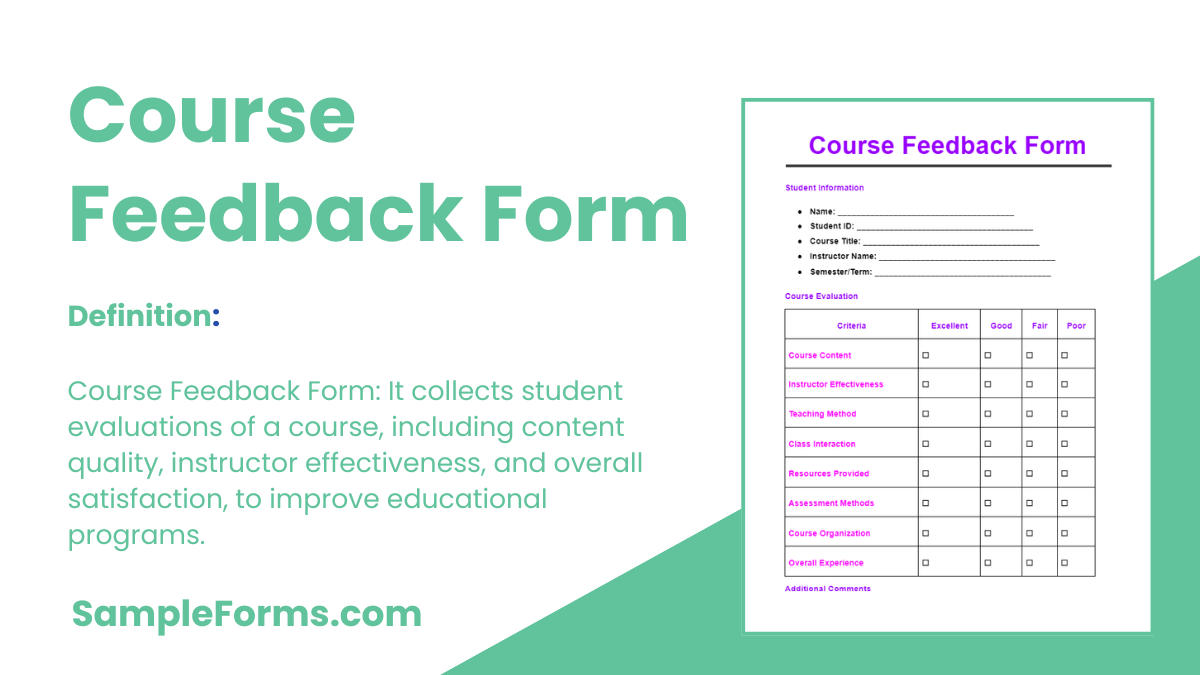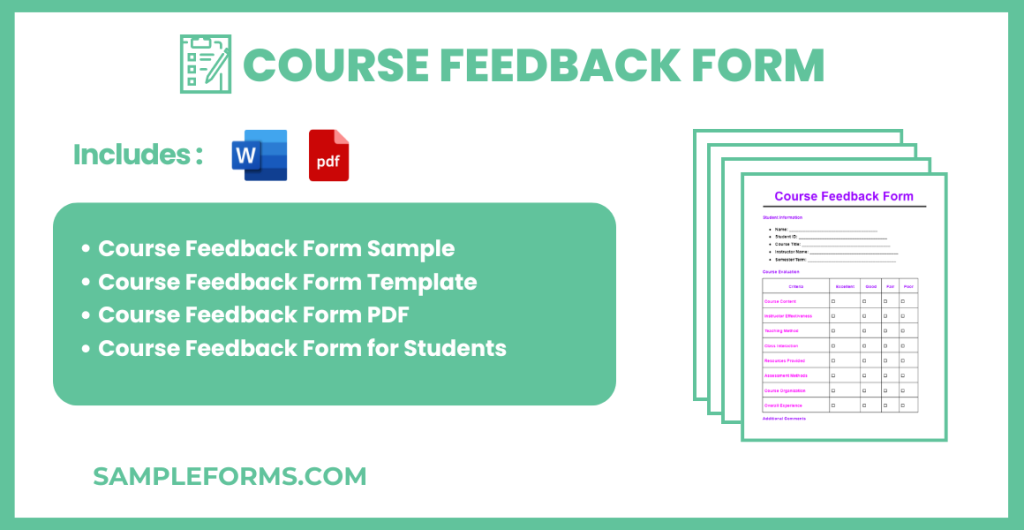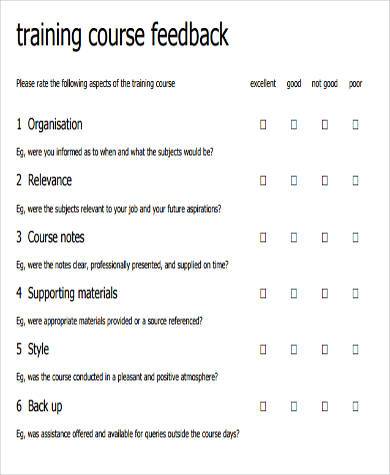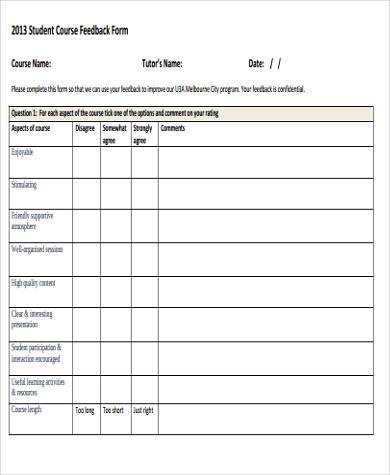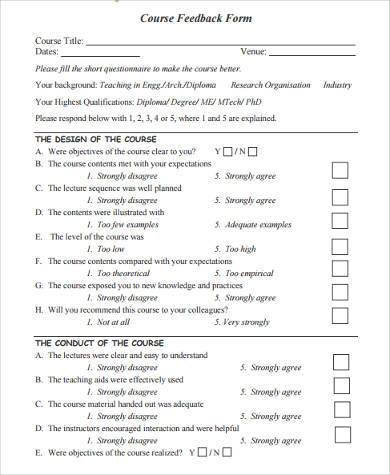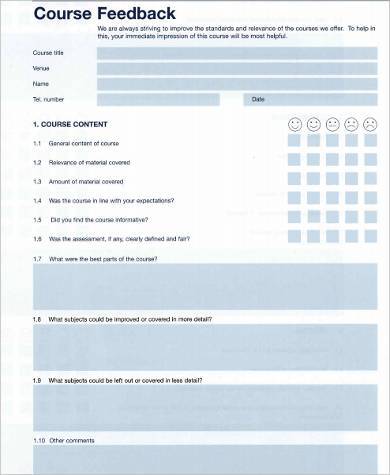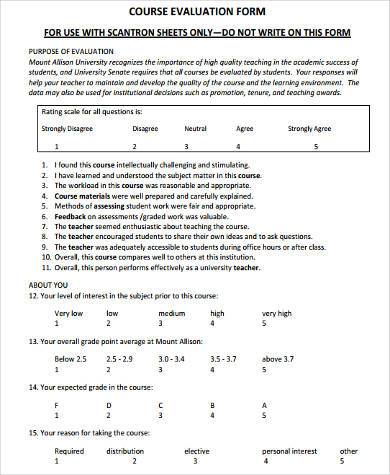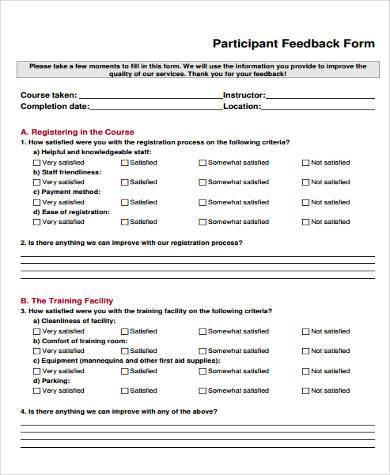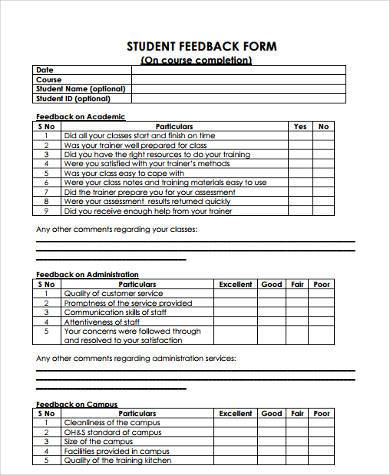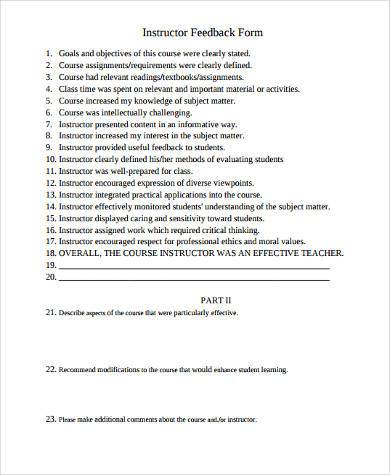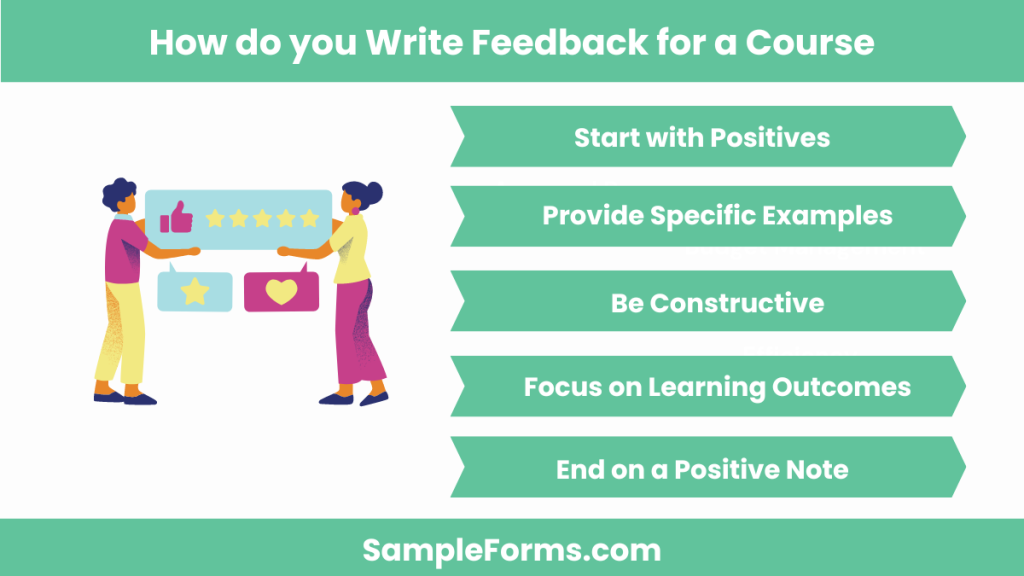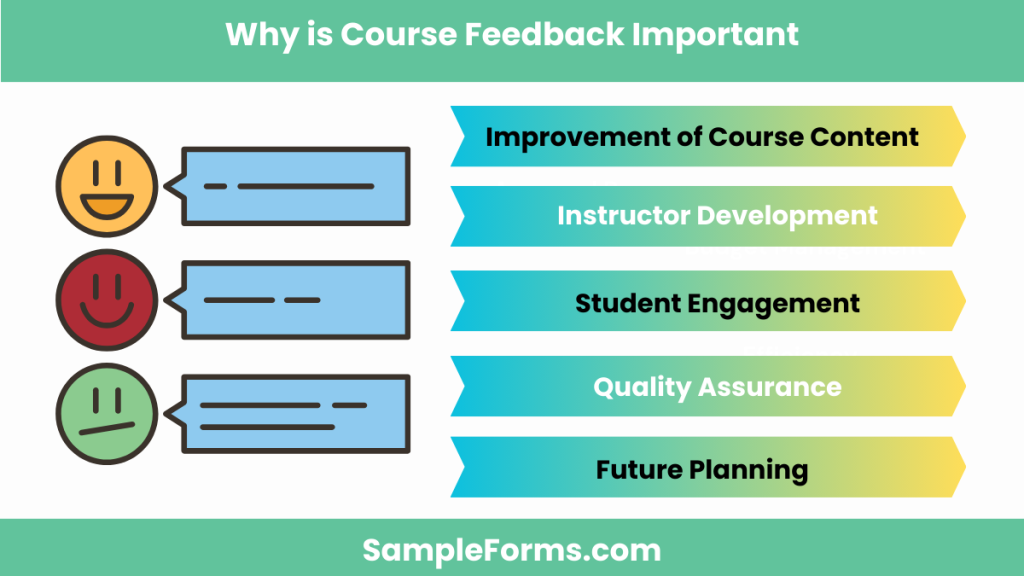A Course Feedback Form is essential for gathering student feedback and improving course quality. This guide provides comprehensive examples and templates for creating effective feedback forms. Explore how to enhance your course evaluation process using the right Feedback Form and Course Evaluation Form.
Download Course Feedback Form Bundle
What is Course Feedback Form?
A Course Feedback Form is a tool used to collect students’ opinions on course content, delivery, and overall experience. It helps educators assess teaching effectiveness and identify areas for improvement. The form typically includes questions about course structure, materials, and instructor performance, providing valuable insights for enhancing educational quality.
Course Feedback Format
Course Feedback Form
Student Information
- Name:
- Course Title:
Course Evaluation
- Content Quality: ☐ Excellent ☐ Good ☐ Fair ☐ Poor
- Instructor Effectiveness: ☐ Excellent ☐ Good ☐ Fair ☐ Poor
Learning Outcomes
- Knowledge Gained: ☐ Excellent ☐ Good ☐ Fair ☐ Poor
- Skills Developed: ☐ Excellent ☐ Good ☐ Fair ☐ Poor
Suggestions for Improvement
- Suggestions:
Overall Satisfaction
- Overall Rating: ☐ Excellent ☐ Good ☐ Fair ☐ Poor
Additional Comments
- Comments:
Course Feedback Form Sample
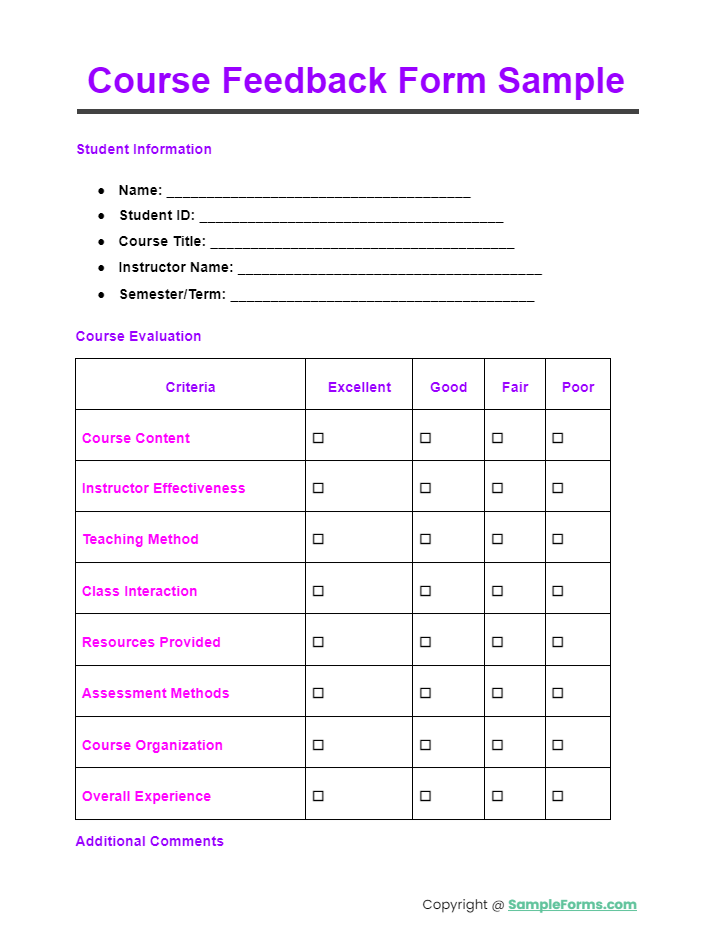
A Course Feedback Form Sample is a pre-designed form that showcases how to effectively gather student opinions on a course. It includes sections on course content, instructor effectiveness, and overall experience. Use this sample to create your own Teacher Feedback Form.
Course Feedback Form Template
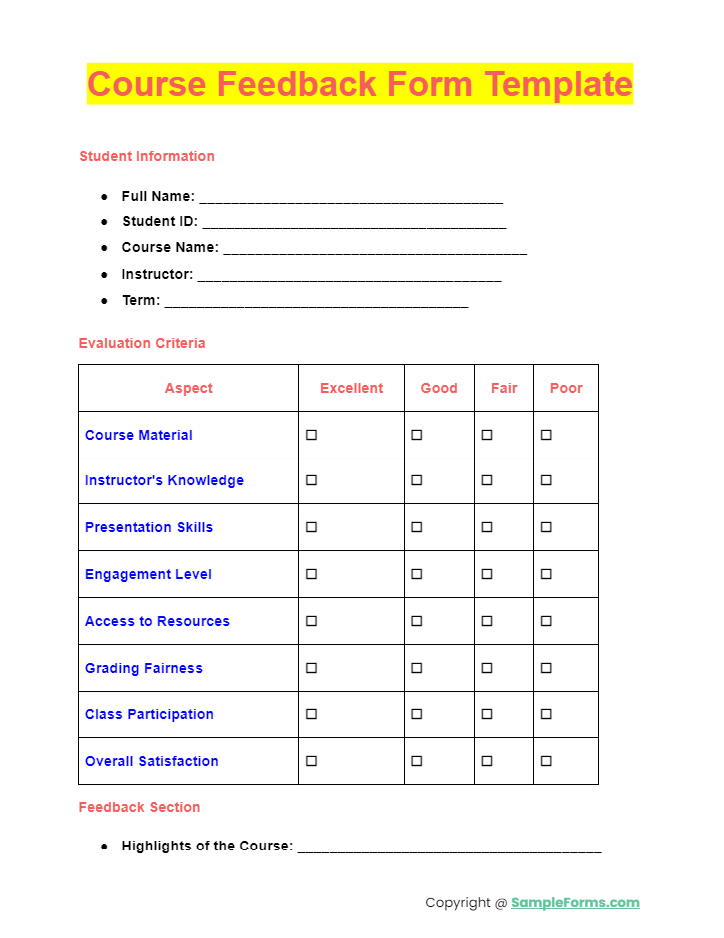
A Course Feedback Form Template is a customizable document that helps instructors easily create feedback forms. It provides a structured layout with questions focusing on different aspects of the course, ensuring comprehensive feedback. This template is ideal for creating a detailed Workshop Feedback Form.
Course Feedback Form PDF
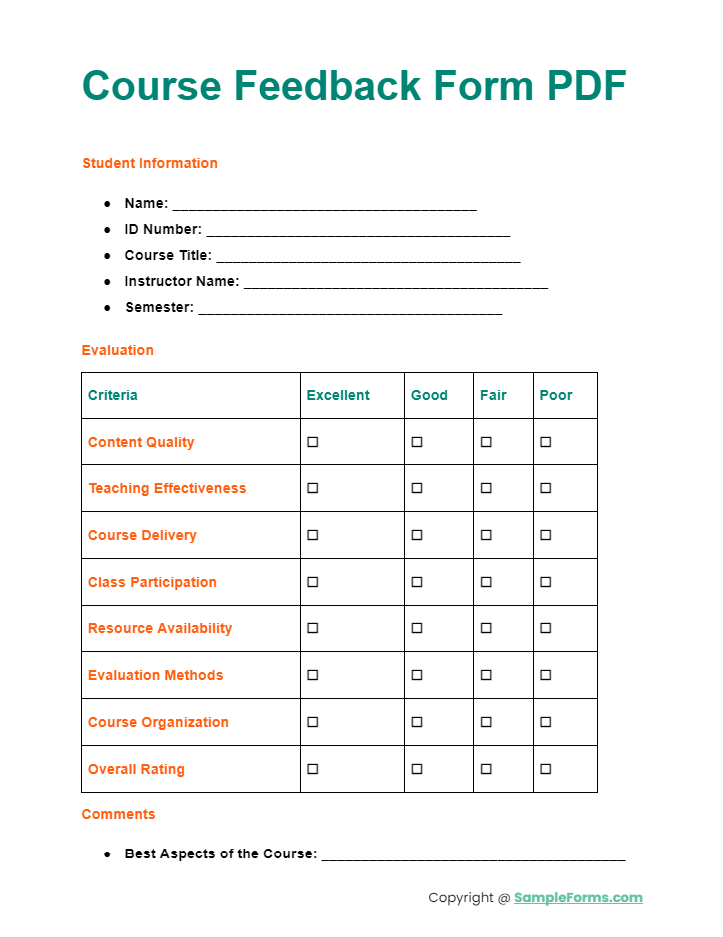
A Course Feedback Form PDF offers a ready-to-use, printable version of a feedback form. It is convenient for collecting student feedback in physical format. This PDF form can be distributed in classrooms or during workshops, making it a useful tool for an Interview Feedback Form.
Course Feedback Form for Students
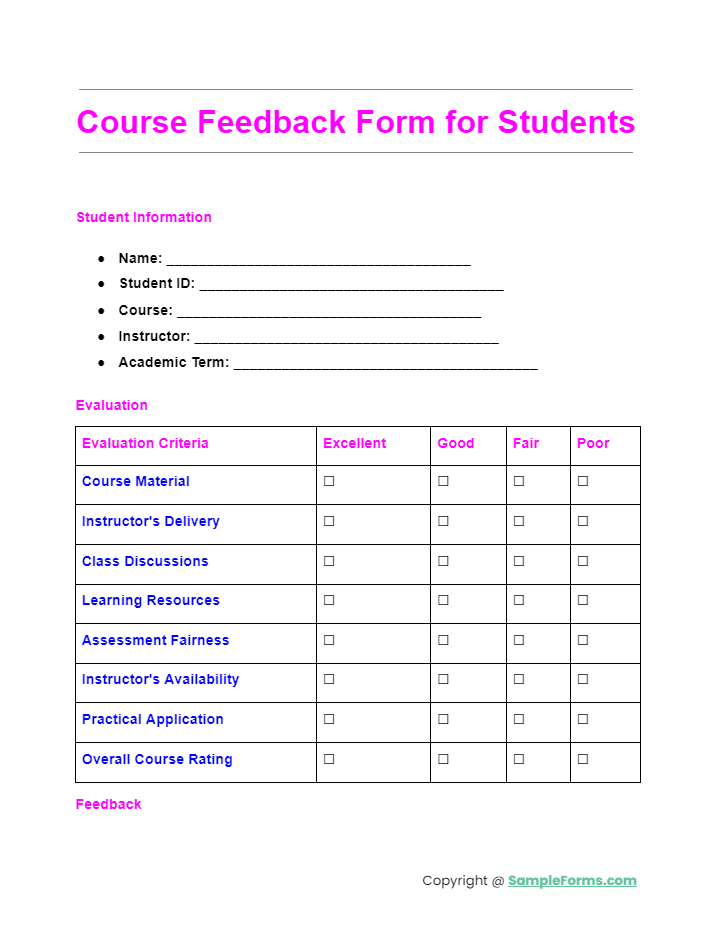
A Course Feedback Form for Students is specifically designed to capture students’ opinions on their learning experience. It includes questions on course material, teaching methods, and engagement. This form helps educators understand student perspectives and improve future courses, similar to a Feedback Form for Doctor.
More Course Feedback Form Samples
Training Course Feedback Form
Student Course Feedback Form
Free Course Feedback Form
Course Feedback Form in PDF
Course Evaluation Feedback Form
Course Participant Feedback Form
Course Completion Feedback Form
Course Instructor Feedback Form
Course Feedback Form Example
How do you write feedback for a course?
Writing effective feedback for a course involves being specific, constructive, and balanced. Focus on the course content, delivery, and overall learning experience.
- Start with Positives: Highlight what worked well in the course.
- Provide Specific Examples: Mention specific aspects or modules that were particularly useful.
- Be Constructive: Suggest areas for improvement without being overly critical.
- Focus on Learning Outcomes: Relate feedback to how the course met your learning objectives.
- End on a Positive Note: Conclude with an overall positive comment about the course experience. You may also see Manager Feedback Form
How to create a course feedback form?
Creating a course feedback form requires a clear understanding of the feedback goals. It should be easy to understand and fill out.
- Define Objectives: Determine what information you want to gather.
- Choose a Format: Decide between a digital or paper form.
- Include Essential Questions: Ask about course content, delivery, and overall experience.
- Use Rating Scales: Implement Likert scales for quantitative feedback.
- Add Open-Ended Questions: Allow for detailed, qualitative feedback. You may also see Event Feedback Form
For an effective form, consider looking at a Demo Feedback Form for structure and content ideas.
What should a good feedback form include?
A good feedback form should be comprehensive, yet concise, and cover all essential aspects of the course.
- Personal Information (Optional): Name, course, date.
- Course Content: Questions about the relevance and clarity of the material.
- Instructor Effectiveness: Questions on teaching style and engagement.
- Learning Outcomes: Questions on whether the course met learning objectives.
- Overall Experience: General satisfaction and suggestions for improvement. You may also see Induction Feedback Form
Review a Project Feedback Form to see how other forms incorporate these elements effectively.
Improving Your Lectures for Your Students – and for Yourself
If you are considerably new to the teaching profession and are discovering that the techniques you are using are ineffective, addressing your weaknesses will prove to be the ideal next move. You can then make creating a pleasant and productive classroom experience your next objective.
There are several ways for you to be able to find out your lapses when it comes to executing an effective and engaging lecture. Although the means are different, they hold the same purpose: to gather the opinions of your students. It can be daunting, especially since you are a novice. But it helps to remember that when it comes to improving oneself, feedback plays a tremendous role.
To have your class or course assessed by the group you are teaching, you can opt to either conduct an online survey or have in-class Training Feedback Form answered anonymously by your students. Another method is to have your students partake in a small group analysis. Whatever method you choose to exercise, you must aim to determine if your overall manner of teaching is effective. Bear in mind that sharpening your skills as a teacher is beneficial not only to your students, but also to you as a professional.
Why is course feedback important?
Course feedback is crucial for continuous improvement and ensuring the course meets the needs of learners.
- Improvement of Course Content: Helps refine and update course material.
- Instructor Development: Provides insights into teaching effectiveness.
- Student Engagement: Ensures the course is engaging and meets student needs.
- Quality Assurance: Maintains high standards of education.
- Future Planning: Assists in planning future courses based on student feedback. You may also see Nursing Feedback Form
Examining a Real Estate Feedback Form can highlight how feedback improves services and experiences.
What are the 4 C’s of feedback?
The 4 C’s of feedback are a framework for providing effective feedback that is Clear, Constructive, Concise, and Complete.
- Clear: Ensure the feedback is easy to understand.
- Constructive: Focus on areas for improvement.
- Concise: Be brief and to the point.
- Complete: Cover all relevant aspects of the course. You may also see Exam Feedback Form
Refer to a Camp Feedback Form to see how these principles are applied in different contexts.
Adhering to specific rules and regulations ensures that study leave is managed effectively. Key rules include:
- Eligibility Criteria: Employees must meet certain criteria, such as tenure and performance, to qualify for study leave.
- Leave Form Submission: Employees must submit a detailed Leave Form specifying the duration and purpose of the leave.
- Approval Process: The leave must be approved by the relevant authorities within the organization.
- Return to Work: Employees must return to work immediately after the study leave ends, with no extensions unless approved.
- Financial Obligations: Any financial support provided by the employer may need to be repaid if the employee leaves the organization shortly after the leave. You may also see Coaching Feedback Form
Why Regularly Obtaining Feedback from Your Students Is Imperative
Apart from being able to find out your weaknesses, there are other benefits that can be reaped from gathering feedback from your students. They can be:
- Being able to have room for reflection. When you know what your students think of you, you will be able to reflect on (and not worry about) your performance. Acquiring feedback enables you to assess yourself effectively.
- Reinforced communication between yourself and your students. Letting your students know that you are open to hearing what they have to say about your techniques is tantamount to bolstering communication.
- Development of new teaching strategies, as well as ways of learning for your students. Being open to feedback will prove to be a win-win for you and your students.
- An immersive classroom experience. This should be your end goal. A lecture that not only imparts knowledge on your students, but also engages them and keeps them immersed all throughout the session. You may also see Conference Feedback Form
How do you give good feedback for a training course?
Provide specific, positive, and constructive comments on what you learned and what was effective. A Observation Feedback Form can provide further structure.
How to write a good course evaluation?
Include specific comments on content, delivery, and outcomes. Use clear language and constructive criticism. Referencing a Medical Feedback Form can guide structuring your evaluation.
How do you write an effective course outcome?
Define clear, measurable, and achievable goals that align with course objectives. Reviewing a Library Feedback Form can help in tracking and evaluating outcomes.
How do I give feedback after a course?
Mention useful aspects, suggest improvements, and discuss how the course met your expectations. Utilizing a Lesson Feedback Form can help organize your thoughts.
How do you praise a training course?
Highlight specific elements that were well-executed, like engaging content and effective teaching methods. A Guest Feedback Form can guide structuring positive feedback.
How do you appreciate a course?
Express gratitude for the knowledge gained, mention standout aspects, and acknowledge the instructor’s efforts. A Peer Feedback Form can frame your appreciation effectively.
How to write a review of a training course?
Summarize the course content, discuss the instructor’s effectiveness, and share your learning outcomes. A Recruitment Feedback Form can offer a template for writing structured reviews.
How do you evaluate the success of a course?
Assess student engagement, learning outcomes, and overall satisfaction through surveys and feedback forms. A New Joinee Feedback Form can provide a framework for evaluation.
Related Posts
-
FREE 6+ Market Research Forms in PDF | MS Word
-
FREE 3+ Feedback Observation Forms in PDF | MS Word
-
Classroom Observation Form
-
Behavior Observation Form
-
FREE 32+ Different Formats for Feedback Forms in PDF | Ms Word | Excel
-
FREE 11+ Property Feedback Forms in PDF | Ms word
-
FREE 11+ Observational Feedback Forms in PDF | MS Word
-
Nursing Feedback Form
-
Form for 360 Degree Feedback
-
FREE 10+ Feedback Forms Aimed at Doctors | PDF
-
FREE 11+ Demo Feedback Forms in PDF | MS Word
-
FREE 11+ Exam and Test Feedback Forms in PDF | Ms Word
-
FREE 10+ Medical Feedback Forms in PDF
-
Induction Feedback Form
-
Coaching Feedback Form
